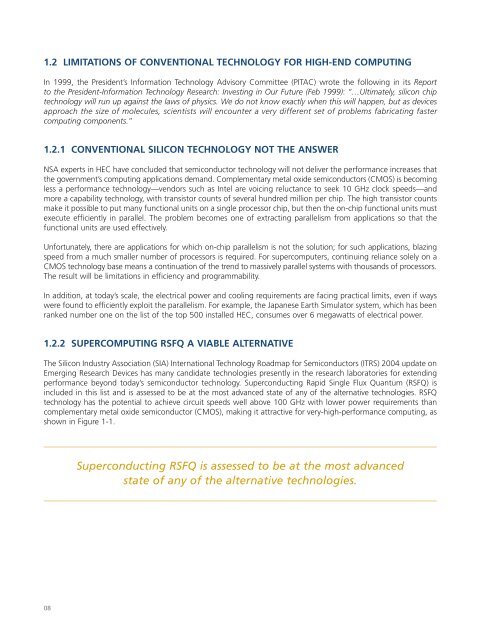Superconducting Technology Assessment - nitrd
Superconducting Technology Assessment - nitrd
Superconducting Technology Assessment - nitrd
Create successful ePaper yourself
Turn your PDF publications into a flip-book with our unique Google optimized e-Paper software.
1.2 LIMITATIONS OF CONVENTIONAL TECHNOLOGY FOR HIGH-END COMPUTING<br />
In 1999, the President’s Information <strong>Technology</strong> Advisory Committee (PITAC) wrote the following in its Report<br />
to the President-Information <strong>Technology</strong> Research: Investing in Our Future (Feb 1999): “…Ultimately, silicon chip<br />
technology will run up against the laws of physics. We do not know exactly when this will happen, but as devices<br />
approach the size of molecules, scientists will encounter a very different set of problems fabricating faster<br />
computing components.”<br />
1.2.1 CONVENTIONAL SILICON TECHNOLOGY NOT THE ANSWER<br />
NSA experts in HEC have concluded that semiconductor technology will not deliver the performance increases that<br />
the government’s computing applications demand. Complementary metal oxide semiconductors (CMOS) is becoming<br />
less a performance technology—vendors such as Intel are voicing reluctance to seek 10 GHz clock speeds—and<br />
more a capability technology, with transistor counts of several hundred million per chip. The high transistor counts<br />
make it possible to put many functional units on a single processor chip, but then the on-chip functional units must<br />
execute efficiently in parallel. The problem becomes one of extracting parallelism from applications so that the<br />
functional units are used effectively.<br />
Unfortunately, there are applications for which on-chip parallelism is not the solution; for such applications, blazing<br />
speed from a much smaller number of processors is required. For supercomputers, continuing reliance solely on a<br />
CMOS technology base means a continuation of the trend to massively parallel systems with thousands of processors.<br />
The result will be limitations in efficiency and programmability.<br />
In addition, at today’s scale, the electrical power and cooling requirements are facing practical limits, even if ways<br />
were found to efficiently exploit the parallelism. For example, the Japanese Earth Simulator system, which has been<br />
ranked number one on the list of the top 500 installed HEC, consumes over 6 megawatts of electrical power.<br />
1.2.2 SUPERCOMPUTING RSFQ A VIABLE ALTERNATIVE<br />
The Silicon Industry Association (SIA) International <strong>Technology</strong> Roadmap for Semiconductors (ITRS) 2004 update on<br />
Emerging Research Devices has many candidate technologies presently in the research laboratories for extending<br />
performance beyond today’s semiconductor technology. <strong>Superconducting</strong> Rapid Single Flux Quantum (RSFQ) is<br />
included in this list and is assessed to be at the most advanced state of any of the alternative technologies. RSFQ<br />
technology has the potential to achieve circuit speeds well above 100 GHz with lower power requirements than<br />
complementary metal oxide semiconductor (CMOS), making it attractive for very-high-performance computing, as<br />
shown in Figure 1-1.<br />
<strong>Superconducting</strong> RSFQ is assessed to be at the most advanced<br />
state of any of the alternative technologies.<br />
08














